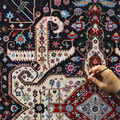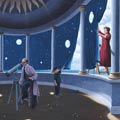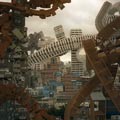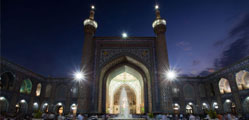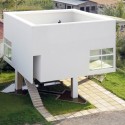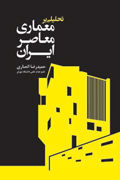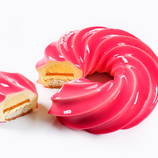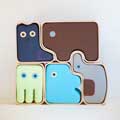این پروژه یک غرفه نمایشگاهیست که توسط گروه سنگاپوری معماری WOW برای جشنوارهی Archifest 2012 طراحی شده. این طور که در سایت جشنواره اومده، رویکرد اصلی امسال اون : «نگاه از دریچه ای تازه به موضوع شهر و همین طور تفکری دوباره دربارهی شهر سنگاپور به عنوان یک اکوسیستم شهری»ست!
به نظرم این طرح شاید از لحاظ بصری و فرمی خیلی نوآوری و پیچیدگی نداشته باشه اما یک رویکرد قابل تامل در طراحیش وجود داره و اون موضوع «Zero Waste»ه؛ طراح تلاش دارد با راهکارهای نوآورانه هدر زمان ، مصالح ، هزینه ها و انرژی رو به صفر برسونه. برای همین هم در این پروژه، طراح از خرپاهای مکعبی آماده که در مسابقات فرمول یک سنگاپور استفاده می شه به عنوان سازه ی اصلی و همچنین از VersiWeb (همین عناصر پلیمری که برای تثبیت خاک در ترانشه های خاکی برای مثال اطراف بزرگراه شهید همت و حکیم استفاده می شه) برای پوشش جداره ها بهره برده. این کار باعث می شه علاوه بر کاهش زمان اجرا و هزینه ها، از مصالحی استفاده بشه که بعد از برچیدن غرفه، میشه در جاهای دیگه ازشون استفاده کرد.
به نظرم این موضوع باید مورد توجه طراحان غرفه و نمایشگاه کشور خودمون هم باشه. یکی از معضلات نمایشگاه های ما همیشه بعد از زمان نمایشگاهه و اون جمع و جور کردن دست ساخت های هدر خودمونه! شاید بشه با این نگاه کمی از ضررها جلوگیری کنیم
© Aaron Pocock
Architects: WOW Architects
Location: Singapore
Architect In Charge: James Tan
Design Team: Fernando Velho, Prabhu Sugumar, Christopher Lee Liang Neng, Yvonne Yung
Year: 2012
Photographs: Aaron Pocock, C3M Studio
WOW Architects | Warner Wong Design was selected over four shortlisted firms in acompetition to design and build the first-ever Pavilion for Singapore’s Archifest 2012. The“Wonder|Wall” is a zero waste pavilion that reuses materials in a new way to extraordinaryfunctions and delight thus engaging and inspiring the hearts and minds of all to Rethink Singapore”.
© Aaron Pocock
Specificity Of The Site
The design of the pavilion was a response to the duality of the site. On the one hand, FortCanning, once know as the “Forbidden Hill” still retains its quiet, reposeful and almost mythicalcharacter. Directly opposite is Clarke Quay, vibrant and bustling with people and activities. Inbewteenis the Foothills that once was a hive for social activities with the public swimming pooland the National Theatre.The proposed pavilion seeks to embody the duality between the two realms, with itspermeable skin. The undulating web inspires curiosity and amazement as well. At certainangles, the membrane looks almost solid like a wall, and when one moves along Wonder|Wall,a “moire” effect is created due to the double cladding around the structure. When viewed onthe perpendicular, the membrane seems totally transparent and merges with the surroundingbuildings and landscape.
© Aaron Pocock
Zero Waste, Buildability and After Life
The zero waste and buildability strategy was developed around two highly rapid deployableand re-useable systems. The first is the main structure, composed of box-truss systemsdeveloped for the Formula One Night race and the National Day Parade. The second is apolymer mesh developed for slope control that has unique attributes that enhance theusability and interaction of the space, the membrane and its landscape system can be reutilizedaround Fort Canning for slope and erosion control. Our zero waste strategy consideredtime, materials, cost and the afterlife of the elements.
The box-truss system, including the rooftakes a maximum of approximately 7 days to delpoy. The membrane takes a maximum ofapproximately 3 days to install. Overall time frame to complete Wonder|Wall erection wouldbe 10-15 days.The cellular membrane once taken down can be re-used for the following:- Fort Canning Hill’s other areas that require slope protection and stabilization.- Donate to a nearby country whose village / farmland has been affected by soil erosion fromslopes.- The steel box-truss once taken down will be re-used in other commercial events along withthe future National Day parades.
© Aaron Pocock
Architecture as Program – Engaging the Public
Normally used as a subterranean soil control technology, the membrane is given a new use asa vertical surface onto which to project, insert, interact and engage with the public. Seminarson Pop Up Farming, and Zero Waste Strategies can be conducted using the Versiwebmembrane as a display surface. The cellular nature of the mesh system also forms “pockets” ofintimate space or crenellations in which seeds of thought are propagated and nurtured.
© C3M Studio
- Archifest “post” cards are distributed to visitors at the entrance and they are encouraged topost thoughts, ideas and memories in the “pockets” to be shared and read by all.
- One of the initial inspirations for the pavilion was the humble straw mat for a park-likeatmosphere. Rolled up Archifest straw mats are inserted into the “pockets” to encouragevisitors to sit and converse, tell stories and share experiences.
- The entire Wonder|Wall is the Urban Pop Up farm with small foliage plants with geo-textilewrapped roots and a hydro-gel planting medium inserted into the cells.
© Aaron Pocock
WOW director, James Tan, who led the Pavilion design team comments, “WOW’s design ethoshas always been to challenge and explore new and innovative ways to create experientiallyrich spaces that are environmentally as well as economically sustainable for all our projects.In the pavilion design, a simple material (Versiweb) was used to create exciting and intriguingspaces that met all the requirements of the competition brief. The Versiweb forms a permeableskin for the pavilion, allowing natural ventilation whilst providing shelter from the sun and rain.
When viewed at different angles, the Pavilion seems to disappear and merged with thesurroundings. In another instance, while walking alongside the Pavilion, a “moire effect” iscreated due to the double layering effect. The Pavilion design is also intended to be a “highlyinteractive platform” for the activities of the Archifest. Straw mats are inserted in the Versiweb“pockets” to encourage visitors to use them for seminars or picnics around the Pavilion.”
Section




